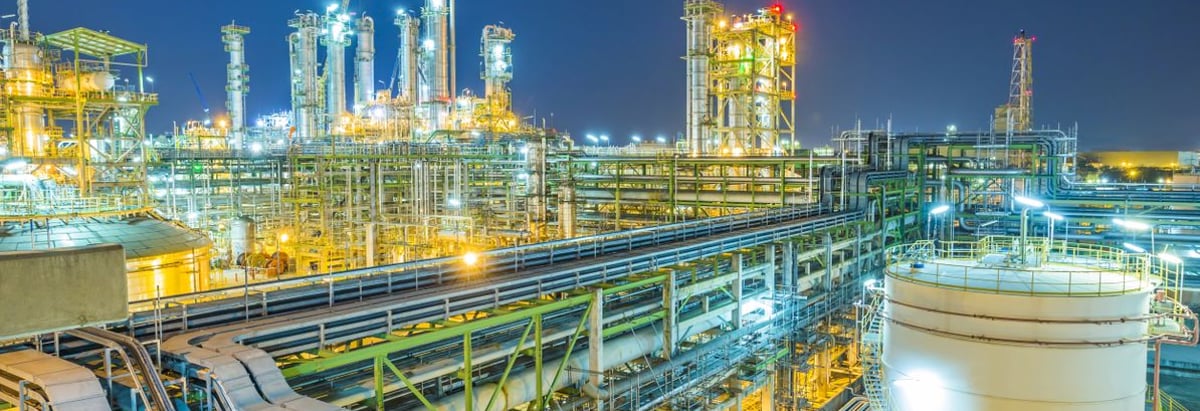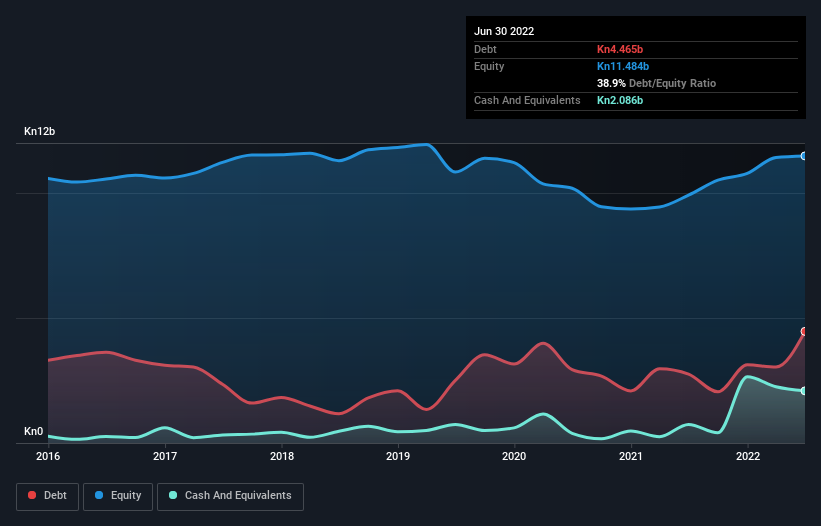
Legendary fund manager Li Lu (who Charlie Munger backed) once said, 'The biggest investment risk is not the volatility of prices, but whether you will suffer a permanent loss of capital.' So it might be obvious that you need to consider debt, when you think about how risky any given stock is, because too much debt can sink a company. Importantly, INA-Industrija nafte, d.d. (ZGSE:INA) does carry debt. But should shareholders be worried about its use of debt?
When Is Debt Dangerous?
Debt and other liabilities become risky for a business when it cannot easily fulfill those obligations, either with free cash flow or by raising capital at an attractive price. Ultimately, if the company can't fulfill its legal obligations to repay debt, shareholders could walk away with nothing. While that is not too common, we often do see indebted companies permanently diluting shareholders because lenders force them to raise capital at a distressed price. Of course, plenty of companies use debt to fund growth, without any negative consequences. The first step when considering a company's debt levels is to consider its cash and debt together.
Check out the opportunities and risks within the XX Oil and Gas industry.
How Much Debt Does INA-Industrija nafte d.d Carry?
As you can see below, at the end of June 2022, INA-Industrija nafte d.d had Kn4.47b of debt, up from Kn2.76b a year ago. Click the image for more detail. However, it also had Kn2.09b in cash, and so its net debt is Kn2.38b.

A Look At INA-Industrija nafte d.d's Liabilities
Zooming in on the latest balance sheet data, we can see that INA-Industrija nafte d.d had liabilities of Kn8.13b due within 12 months and liabilities of Kn6.14b due beyond that. On the other hand, it had cash of Kn2.09b and Kn3.77b worth of receivables due within a year. So it has liabilities totalling Kn8.42b more than its cash and near-term receivables, combined.
INA-Industrija nafte d.d has a market capitalization of Kn35.0b, so it could very likely raise cash to ameliorate its balance sheet, if the need arose. But we definitely want to keep our eyes open to indications that its debt is bringing too much risk.
In order to size up a company's debt relative to its earnings, we calculate its net debt divided by its earnings before interest, tax, depreciation, and amortization (EBITDA) and its earnings before interest and tax (EBIT) divided by its interest expense (its interest cover). Thus we consider debt relative to earnings both with and without depreciation and amortization expenses.
INA-Industrija nafte d.d's net debt is only 0.51 times its EBITDA. And its EBIT covers its interest expense a whopping 67.6 times over. So you could argue it is no more threatened by its debt than an elephant is by a mouse. Even more impressive was the fact that INA-Industrija nafte d.d grew its EBIT by 399% over twelve months. That boost will make it even easier to pay down debt going forward. The balance sheet is clearly the area to focus on when you are analysing debt. But you can't view debt in total isolation; since INA-Industrija nafte d.d will need earnings to service that debt. So if you're keen to discover more about its earnings, it might be worth checking out this graph of its long term earnings trend.
But our final consideration is also important, because a company cannot pay debt with paper profits; it needs cold hard cash. So it's worth checking how much of that EBIT is backed by free cash flow. Over the last two years, INA-Industrija nafte d.d reported free cash flow worth 15% of its EBIT, which is really quite low. That limp level of cash conversion undermines its ability to manage and pay down debt.
Our View
Happily, INA-Industrija nafte d.d's impressive interest cover implies it has the upper hand on its debt. But, on a more sombre note, we are a little concerned by its conversion of EBIT to free cash flow. Taking all this data into account, it seems to us that INA-Industrija nafte d.d takes a pretty sensible approach to debt. That means they are taking on a bit more risk, in the hope of boosting shareholder returns. There's no doubt that we learn most about debt from the balance sheet. But ultimately, every company can contain risks that exist outside of the balance sheet. We've identified 3 warning signs with INA-Industrija nafte d.d (at least 2 which are a bit unpleasant) , and understanding them should be part of your investment process.
If you're interested in investing in businesses that can grow profits without the burden of debt, then check out this free list of growing businesses that have net cash on the balance sheet.
New: AI Stock Screener & Alerts
Our new AI Stock Screener scans the market every day to uncover opportunities.
• Dividend Powerhouses (3%+ Yield)
• Undervalued Small Caps with Insider Buying
• High growth Tech and AI Companies
Or build your own from over 50 metrics.
Have feedback on this article? Concerned about the content? Get in touch with us directly. Alternatively, email editorial-team (at) simplywallst.com.
This article by Simply Wall St is general in nature. We provide commentary based on historical data and analyst forecasts only using an unbiased methodology and our articles are not intended to be financial advice. It does not constitute a recommendation to buy or sell any stock, and does not take account of your objectives, or your financial situation. We aim to bring you long-term focused analysis driven by fundamental data. Note that our analysis may not factor in the latest price-sensitive company announcements or qualitative material. Simply Wall St has no position in any stocks mentioned.
About ZGSE:INA
INA-Industrija nafte d.d
Explores for, produces, refines, and sells oil and gas.
Solid track record with adequate balance sheet.

